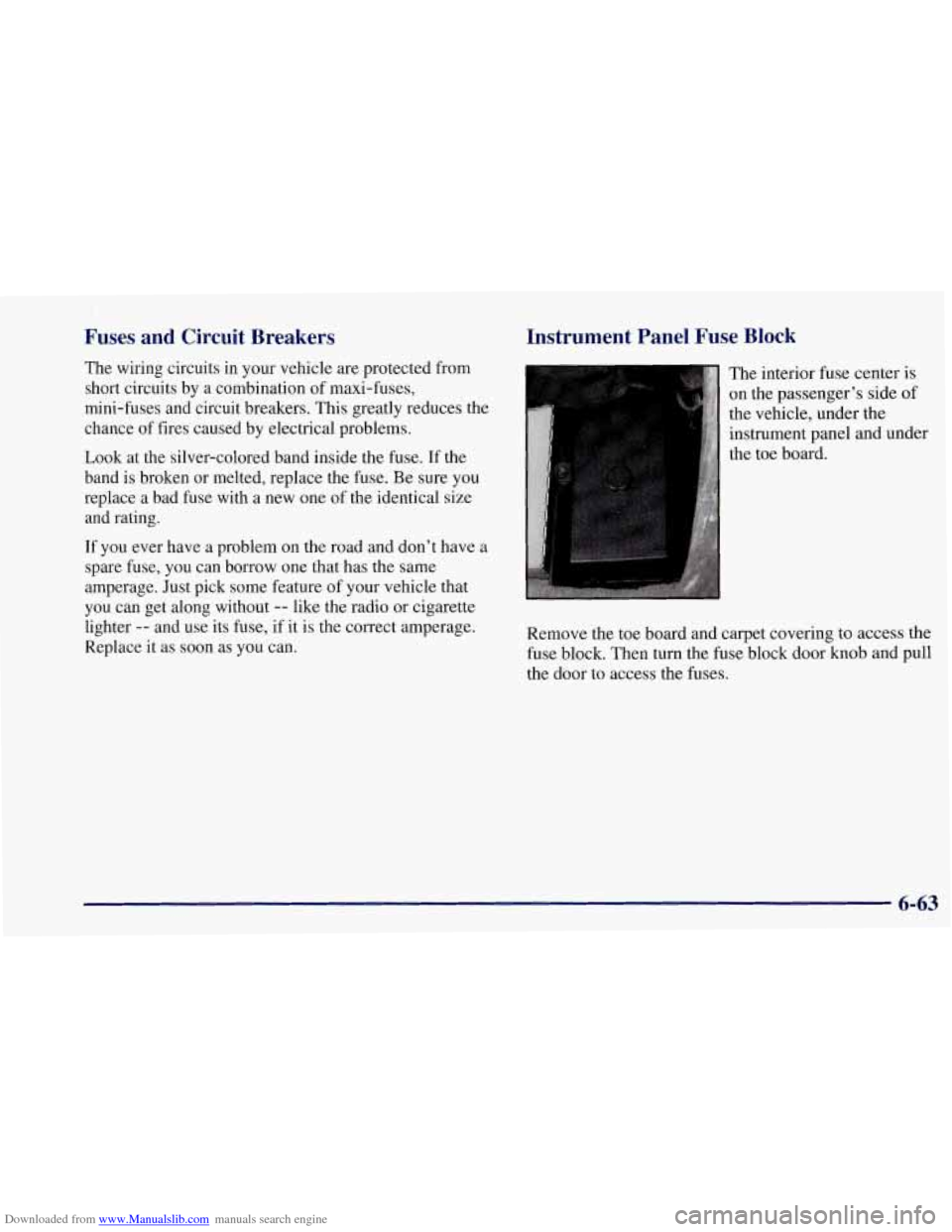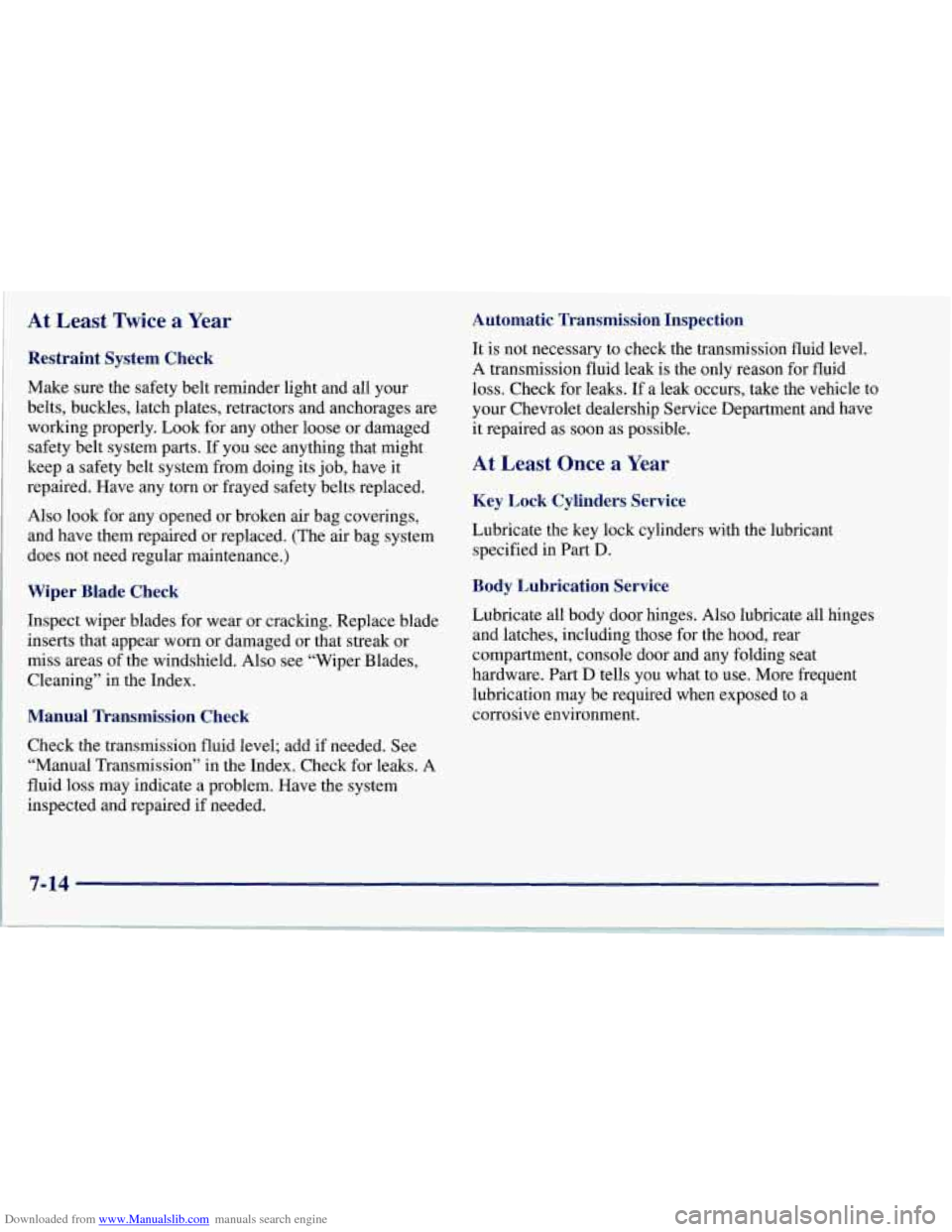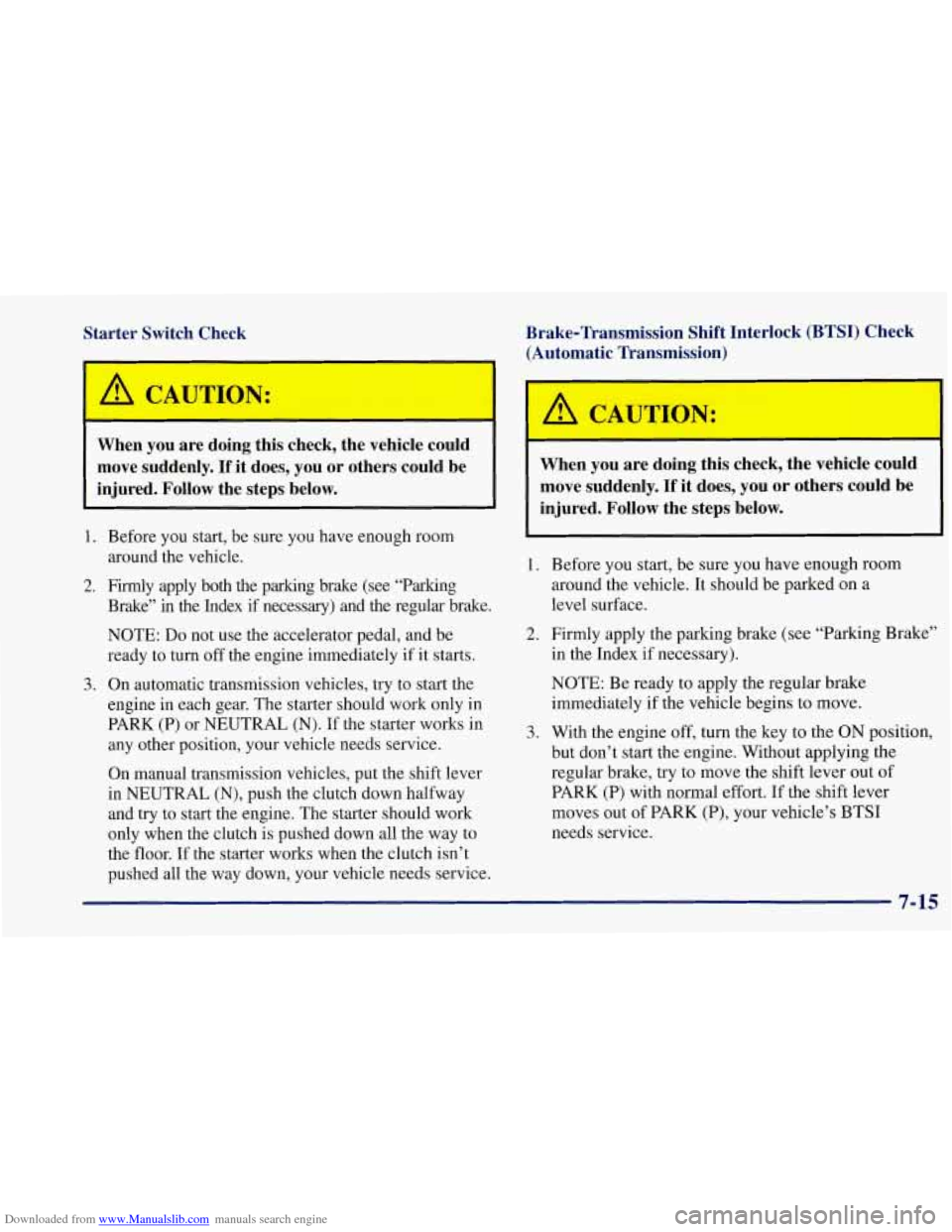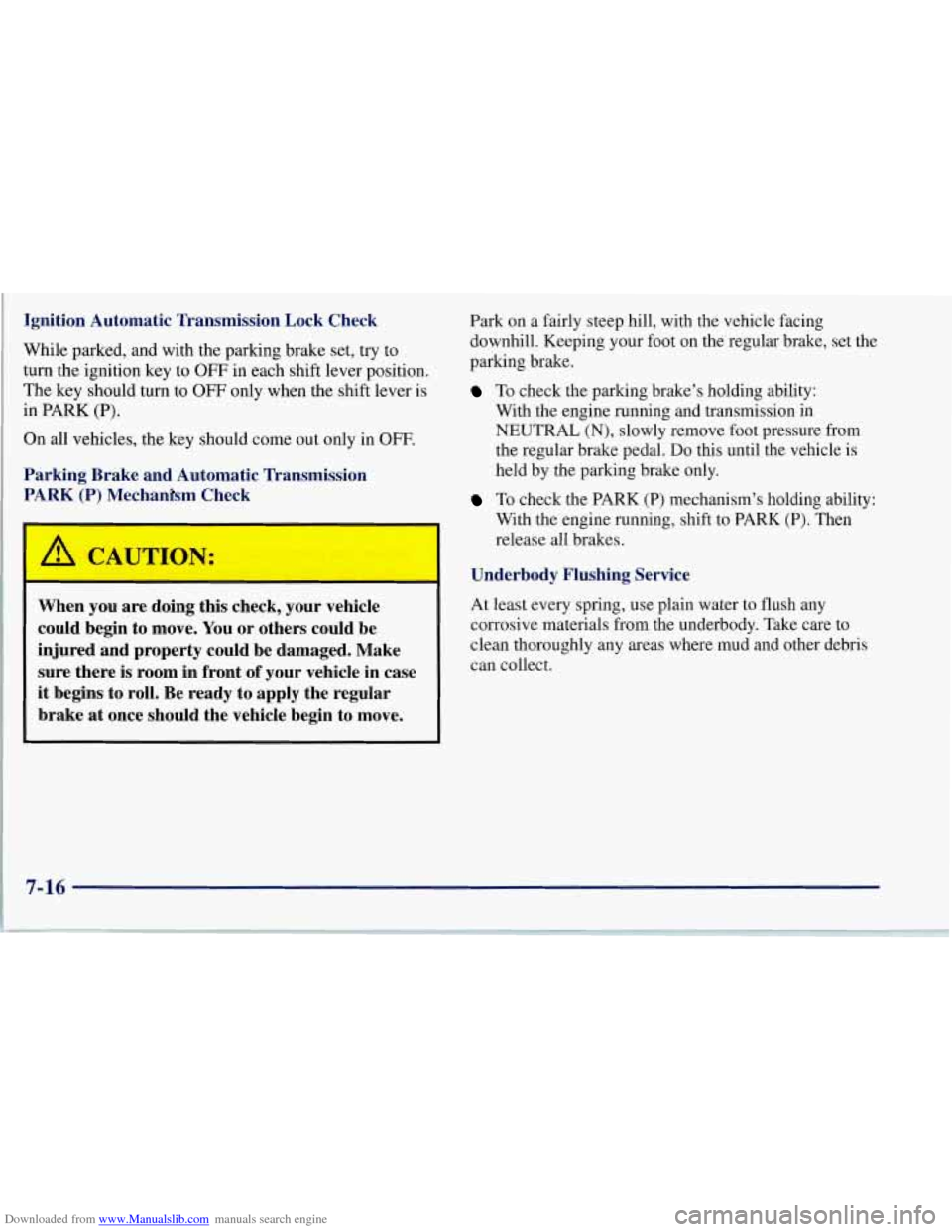Page 298 of 356

Downloaded from www.Manualslib.com manuals search engine Fuses and Circuit Breakers
The wiring circuits in your vehicle are protected from
short circuits by a combination of maxi-fuses,
mini-fuses and circuit breakers. This greatly reduces the
chance of fires caused by electrical problems.
Look at the silver-colored band inside the fuse. If the
band is broken or melted, replace the fuse. Be sure you
replace a bad fuse with a new one of the identical size
and rating.
If you ever have a problem on the road and don’t have a
spare fuse, you can borrow one that has the same
amperage. Just pick some feature of your vehicle that
you can get along without
-- like the radio or cigarette
lighter
-- and use its fuse, if it is the correct amperage.
Replace it as soon as you can.
Instrument Panel Fuse Block
The interior fuse center is
on the passenger’s side of
the vehicle, under the
instrument panel and under
the toe board.
Remove the toe board and carpet covering
to access the
fuse block. Then turn the fuse block door
knob and pull
the door to access the fuses.
6-63
Page 299 of 356
Downloaded from www.Manualslib.com manuals search engine /
p4mrnm
SPAREFUSES UNDER HOOD
Fuse Usage
1 Console Cigarette Lighter
2 Monitored (Inadvertent) Load Control
3 Lumbar Seat
4 Driver Seat Control Module
5 Radio
Fuse
6
7
8
9
10
11
12
13
14
15 16
17
18
19
20
21
Usage
Parking Lamps, Taillamps
Cigar Lighter
Stop Hazard Flashers
Body Control Module
Windshield Wipermasher
Accessory Power
Blank Body Control Module
Crank
Hazard/Turn Signal
Air Bag
Blank HVAC Controls
Instrument Panel Control
Cruise Control
Brake Transmission Shift Interlock
6-64
~ . . -
Page 301 of 356
Downloaded from www.Manualslib.com manuals search engine Engine Compartment Fuse Block
There is one fuse block in the engine compartment
located on the passenger’s side of the vehicle in front
of
the battery.
J
i EATT
J
Fuse
1
2
3
4
5
6
Usage
Rear Fog Lamp
Approach
Right Headlamp Motor
Left Headlamp Motor
Anti-Lock Brakes
Fog Lamp
‘ 6-66
Page 303 of 356
Downloaded from www.Manualslib.com manuals search engine Fuse
35
36
37
38 39
40
41
42
43
44
Usage
Micro Relay - Fuel Pump
Micro Relay
- Horn
Micro Relay - Rear Fog Lamp
Micro Relay
- Back-up Lamps
Micro Relay
- Fog Lamp
Micro Relay
- AIR Solenoid
Micro Relay
- Selective Real Time
Damping
Mini Relay
- Ignition
Mini Relay
- Cooling Fan 2
Mini Relay
- Cooling Fan 3
Fuse
45
46
47
48
49
50
51
52
53
54
Usage
Mini Relay - Cooling Fan 1
Maxi Fuse - Cooling Fan 2
Blank
Blank
Maxi Fuse
- Cooling Fan 1
Maxi Fuse - Air Pump
Blank
Maxi Fuse
- Anti-Lock Brakes
Anti-Lock Brakes and Selective Real
Time Damping Electronics
Fuse Puller
Page 321 of 356

Downloaded from www.Manualslib.com manuals search engine At Least *ice a Year
Restraint System Check
Make sure the safety belt reminder light and all your
belts, buckles, latch plates, retractors and anchorages are
working properly. Look for any other loose or damaged
safety belt system parts. If you see anything that might
keep a safety belt system from doing its job, have it
repaired. Have any torn or frayed safety belts replaced.
Also look for any opened or broken air bag coverings,
and have them repaired or replaced. (The air bag system
does not need regular maintenance.)
Wiper Blade Check
Inspect wiper blades for wear or cracking. Replace blade
inserts that appear worn or damaged or that streak or
miss areas of the windshield. Also see “Wiper Blades,
Cleaning’’
in the Index.
Manual Transmission Check
Check the transmission fluid level; add if needed. See
“Manual Transmission” in the Index. Check for leaks. A
fluid
loss may indicate a problem. Have the system
inspected and repaired if needed.
Automatic Transmission Inspection
It is not necessary to check the transmission fluid level.
A transmission fluid leak is the only reason for fluid
loss. Check for leaks. If a leak occurs, take the vehicle to
your Chevrolet dealership Service Department and have
it repaired as soon as possible.
At Least Once a Year
Key Lock Cylinders Service
Lubricate the key lock cylinders with the lubricant
specified in Part D.
Body Lubrication Service
Lubricate all body door hinges. Also lubricate all hinges
and latches, including those for the hood, rear
compartment, console door and any folding seat
hardware. Part
D tells you what to use. More frequent
lubrication may be required when exposed to a
corrosive environment.
Page 322 of 356

Downloaded from www.Manualslib.com manuals search engine Starter Switch Check
m
Brake-Transmission Shift Interlock (BTSI) Check (Automatic Transmission)
When you are doing this check, the vehicle could
move suddenly. If it does, you or others could be
injured. Follow the steps below.
1. Before you start, be sure you have enough room
around the vehicle.
2. Firmly apply both the parking brake (see “Parking
Brake” in the Index if necessary) and the regular brake.
NOTE:
Do not use the accelerator pedal, and be
ready to turn off the engine immediately if it starts.
3. On automatic transmission vehicles, try to start the
engine in each gear. The starter should work only in
PARK (P) or NEUTRAL
(N). If the starter works in
any other position, your vehicle needs service.
On manual transmission vehicles, put the shift lever
in NEUTRAL (N), push the clutch down halfway
and try to start the engine. The starter should work
only when the clutch is pushed down all the way to
the floor. If the starter works when the clutch isn’t
pushed all the way down, your vehicle needs service.
A CAUTION:
When you are doing this check, the vehicle could
move suddenly. If it does, you or others could be
injured. Follow the steps below.
1.
2.
3.
Before you start, be sure you have enough room
around the vehicle. It should be parked on a
level surface.
Firmly apply the parking brake
(see “Parking Brake”
in the Index if necessary).
NOTE: Be ready to apply the regular brake
immediately
if the vehicle begins to move.
With the engine off, turn the key to the
ON position,
but don’t start the engine. Without applying the
regular brake, try to move the shift lever out
of
PARK (P) with normal effort. If the shift lever
moves out of PARK (P), your vehicle’s
BTSI
needs service.
7-15
Page 323 of 356

Downloaded from www.Manualslib.com manuals search engine Ignition Automatic Transmission Lock Check
While parked, and with the parking brake set, try to
turn the ignition key
to OFF in each shift lever position.
The key should turn to
OFF only when the shift lever is
in PARK (P).
On all vehicles, the key should come out only in
OFF.
Parking Brake and Automatic Transmission
PP-K(P)” .mCt k
A CAUTION:
When you are doing this check, your vehicle
could begin to move. You or others could be
injured and property could be damaged. Make
sure there
is room in front of your vehicle in case
it begins to roll. Be ready to apply the regular
brake at once should the vehicle begin to move.
Park on a fairly steep hill, with the vehicle facing
downhill. Keeping your foot on the regular brake, set the
parking brake.
To check the parking brake’s holding ability:
With the engine running and transmission in
NEUTRAL
(N), slowly remove foot pressure from
the regular brake pedal.
Do this until the vehicle is
held by the parking brake only.
To check the PARK (P) mechanism’s holding ability:
With the engine running, shift to PARK (P). Then
release all brakes.
Underbody Flushing Service
At least every spring, use plain water to flush any
corrosive materials from the underbody. Take care to
clean thoroughly any areas where mud and other debris
can collect.
Page 326 of 356

Downloaded from www.Manualslib.com manuals search engine USAGE
Key Lock
Cylinders
Rear Axle
(Limited-Slip
Differential)
Windshield Washer Solvent
FLUIDLUBRICANT
Multi-Pur ose lubricant,
Superlube (GM Part
No. 12346241 or equivalent).
Axle Lubricant (GM Part
No. 12345977) and
4 ounces
(1 18 ml) of Limited-Slip
Differential Lubricant Additive (GM Part No. 1052358 or
equivalent) where required. See “Rear Axle” in the Index.
GM Optikleen@ Washer
Solvent (GM Part No. 105
15 15)
or equivalent.
I USAGE
Hood Latch
Assembly,
Pivots, Spring Anchor and
Release Pawl
Hood and Door Hinges
Weatherstrip Conditioning
FLUIDLUBRICANT
Lubriplate lubricant aerosol (GM
Part No. 12346293 or equivalent)
or lubricant meeting requirements
of NLGI
## 2, Category LB or
GC-LB.
Multi-purpose lubricant,
Superlube@ (GM Part
No. 12346241 or equivalent).
Dielectric Silicone Grease (GM
Part
No. 12345579 or equivalent).
See “Replacement Parts” in the Index for recommended
replacement filters and spark plugs.
7-19